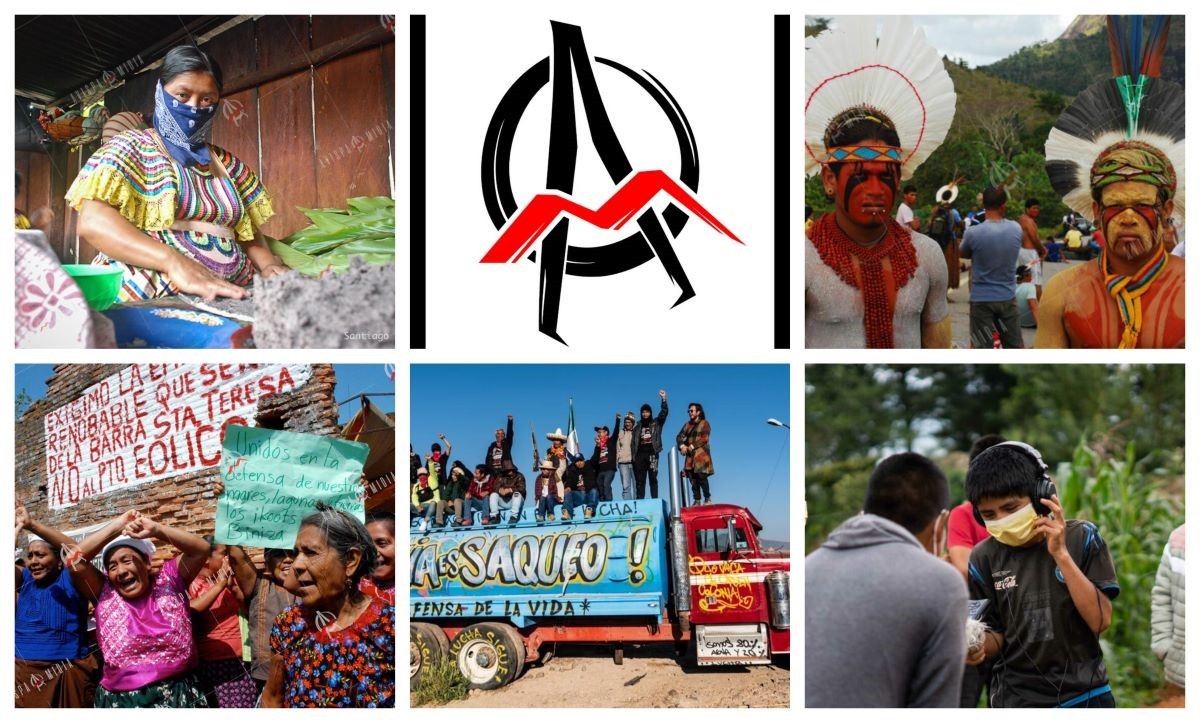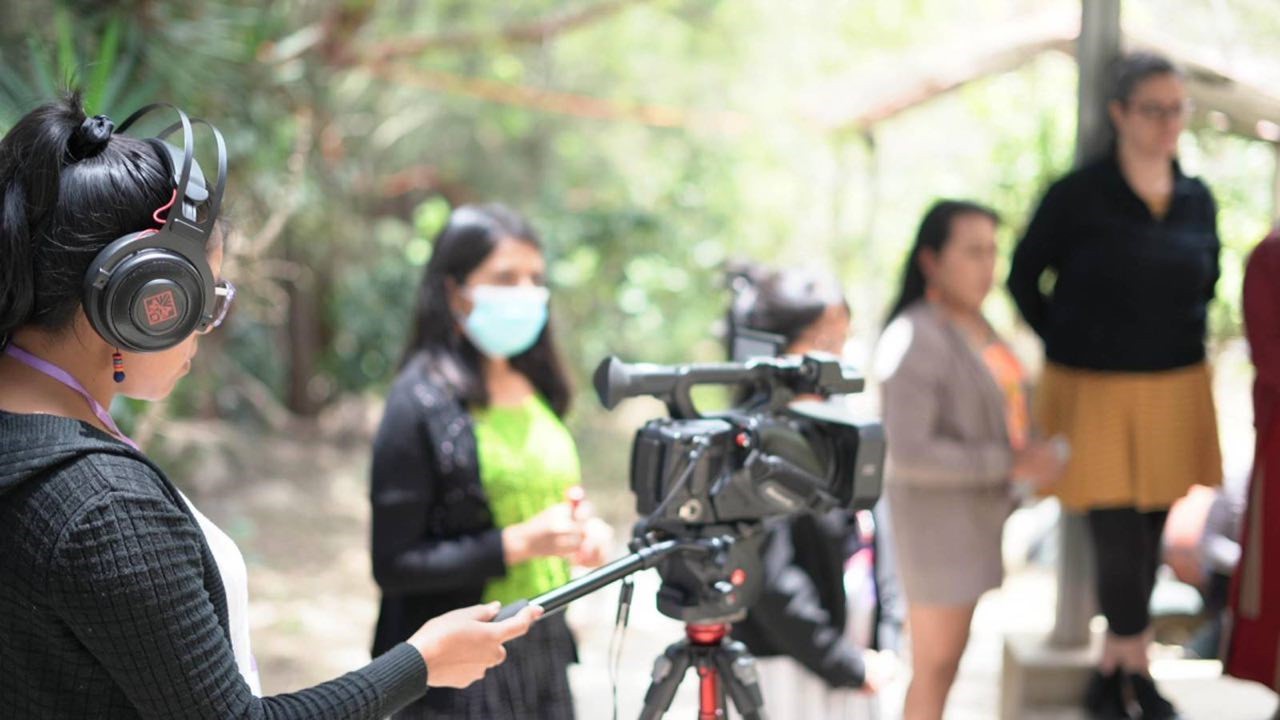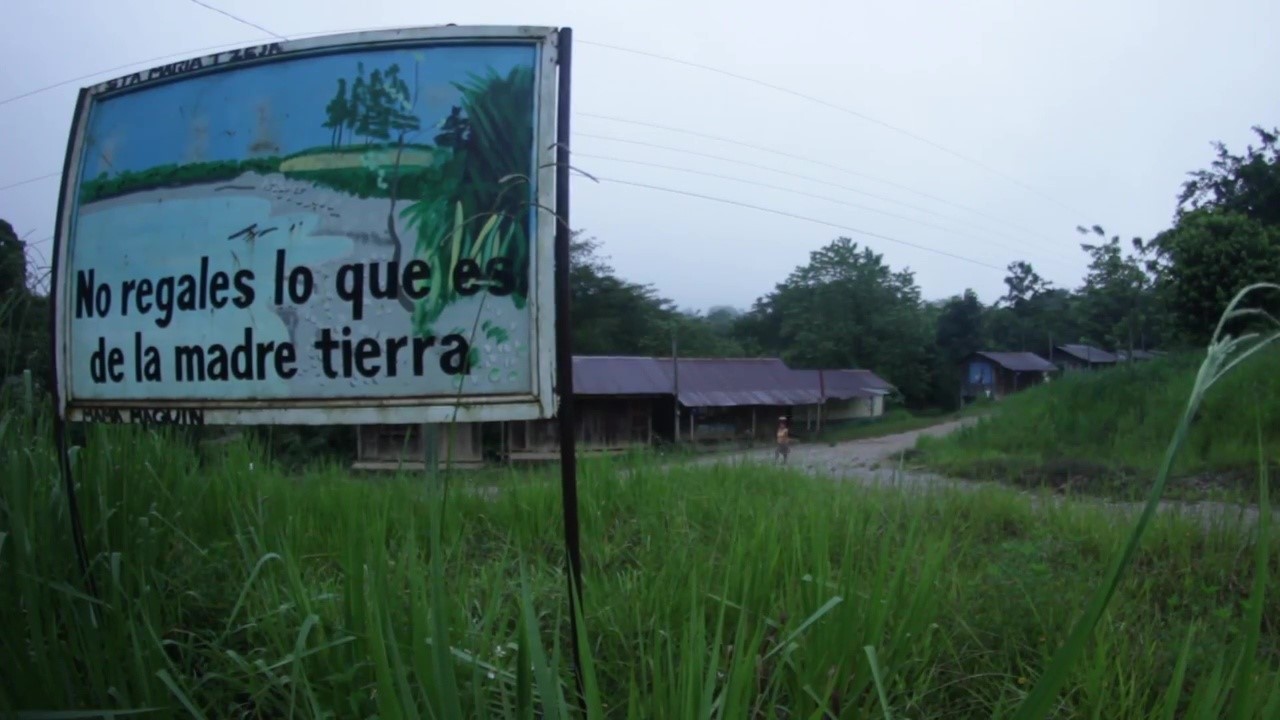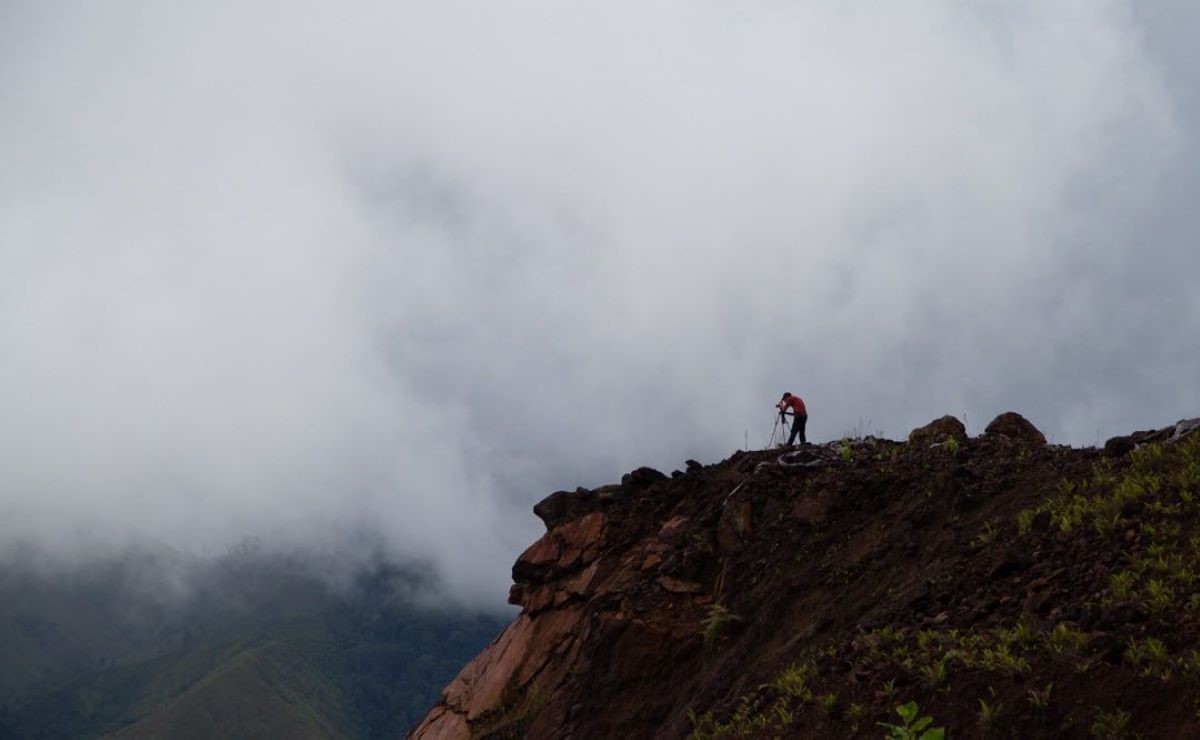Filed under: Featured, IGD, Interviews, Mexico

The following features an interview between IGD and Avispa Midia about the role of independent and autonomous media in social struggles in Latin America and beyond. To read the Spanish version of this interview go here.
IGD: Can you tell us a little about the history of Avispa Midia and how it came about?
AM: Avispa’s history is rooted in our previous involvement with alternative media, and directly with activism. Some of us come from other media projects like SubVersiones and Desinformémonos. There are also compañeras from Brazil who participated with the Free Media Center in Brazil, along with other community radio projects.
Avispa is an initiative that emerged initially in Brazil at the end of 2014 and beginning of 2015, in the context of the forced disappearance of the 43 students of the Normal Rural School of Ayotzinapa, Guerrero. We took it upon ourselves, together with the families of the disappeared students of Ayotzinapa, to carry out a tour of South America. At that moment, we went to Brazil, Argentina, and Uruguay. We coordinated with different groups and collectives to receive the family members of the disappeared students and to visit resistance processes in the south of the continent. It was in that moment that we began to articulate our work into a collective project grounded in communication.
Later, we returned to Mexico, and the bulk of the collective concentrated here. However, there are folks who participate in this project from many different geographies including Colombia, Peru, Guatemala, El Salvador, Honduras. There are compas in the United States and Canada, some in Europe. There are many different collectives who contribute to the work of this collectivity, with audiovisual material, reports, translations, multimedia creation, among other media and communication formats.
IGD: What radical/autonomous media projects inspired you all to start this one?
AM: More than a specific media project, what inspired us was a political identity, and that political identity is Zapatismo. The Zapatista movement launched its call to organize, everyone according to their modes and forms, according to their times and limitations. We responded to that call with the tools of communication. We consider media to be a terrain of struggle where we must confront the commercial and hegemonic media. We are clear that there is no impartiality in the media. On the contrary, the grand majority of the conventional media serve the interests of the state and capital, personal interests, as well as certain groups of power.
With our contribution, our interests are strictly political. They are to strengthen processes of self-management, of anarchist, autonomous, and alternative organization emerging from below. We look to the Zapatista movement as a very important inspiration for Avispa Midia. We maintain an editorial line which seeks to strengthen these movements, particularly in the different geographies of Latin America. We also turn to other geographies like the Caribbean, Haiti in particular, or the other side of the world in Europe, for what is happening currently in Germany, France, and other countries.

IGD: How does Avispa Midia understand and practice independent journalism?
AM: Our vision of independent journalism begins with ourselves drawing out the agenda, defining the thematic and political orientation. Nobody determines what, when, where and how we do things. The majority of our work is done on the ground in the territories in direct contact with the organizational processes and movements. That implies a heavy economic, material, and physical burden which is taken on according to our possibilities. The majority of us live day-to-day, our politics are embedded in daily life. From there we also see the question of autonomy.
We rely on the solidarity of other processes similar to ours, of peoples, collectives, and organizations who also fight for a new, just, dignified life, where self-managed and autonomous processes like Avispa Midia can thrive. We don’t receive money from advertising, nor are we financed by any foundation, much less a political party or company.
In some cases, for the elaboration of certain materials, we have competed for grants to carry out investigative or audiovisual reports which require several months to complete, depending on the subject matter. With this, we can sometimes help cover the expenses necessary to sustain this project as a whole.
For this reason, we are experimenting with different strategies to raise funds. For example, we are currently pushing a subscription campaign. We believe it’s a way to establish links between different peoples and collectivities interested in our work, and to strengthen solidarity between movements and organizational processes of the different geographies with which we have established contact over the years.
We believe the strength to sustain and continue Avispa Midia will come from this collective force. With the extensive effort and heart put into this project, we have taken steps forward. However, at the same time, more necessities have arisen, more work. Thus, we continue to explore ways in which we can sustain the project with the limitations that we have. That is why we turn to the solidarity of the compañerxs in Mexico, Brazil, and around the world.
IGD: What role do you all think independent/autonomous media plays in social struggles? In particular, what do you envision as Avispa Midia’s role in the media landscape in Mexico and why is it important?
AM: We constantly analyze the political, economic, and social context in which we live. Sometimes we are ambitious, seeking not only to do local or regional analysis, but to expand our vision with a geopolitical scope, yet always connecting it to local events.
We consider communication, the conventional communication of the mass media and the huge corporations, to play a determining role in the so-called hybrid or nonconventional wars, better known as fourth-generation warfare. That is to say, the enemy is society in general. The tools used, including communication, are focused on the construction of a collective consciousness disciplined for the market. They are focused on disciplining society for certain politics and economics, so that we can adjust ourselves to the new scenarios presented by the environmental and climate crisis, in addition to the other multiple crises that we are currently facing.
In this sense, we consider it fundamental to directly confront these discourses, to try to disarticulate them, to unravel and break down this information, this bombardment of communication that isn’t necessarily meant to serve or benefit movements and organizing processes, Indigenous communities, or collectives. That is why we consider investigative journalism to be very important. It is there where we have gotten the most attention. When we speak with data, when we use solid information, with sources that sustain claims which cannot so easily be countered. In this way, investigative journalism is the backbone of our work.
However, we also utilize multimedia tools like video, animation, audio, and photography to expand our reach. We have compiled a large archive of these resources throughout the almost ten years in which we have sustained this project. With this we feel that we have contributed our grain of sand. Fortunately, some of our material has been replicated, or been used by movements and organizing processes in their legal battles, or for their own internal analysis and construction of strategies. There have also been times when we have been called on directly by movements or organizational processes to contribute with certain media tools or material.

IGD: Do you all have any reflections on the “medios libres” movement in Mexico and Latin America? Would you all call it a movement? What’s been successful, what hasn’t?
AM: For us, it is important to establish relationships and alliances with different initiatives that are constantly emerging, and others that have already been around for a while, including some longer than us. We recognize the enormous value of communication carried out from below. For that, we value the joint work and the alliances that we can create and cultivate between different groups of communication with whom we share objectives.
On the other hand, we consider that media projects often fall apart for two reasons. One is for the lack of economic resources and materials, and not appropriating the tools that are necessary at certain circumstantial moments. They also fall apart because projects receive funds that have the specific objective of disarticulation. We have seen the way economic resources are used to weaken independent media projects. There are many foundations and NGO’s who are inclined to finance free and alternative media projects. Yet, we understand their logic, their politics, and their underlying objectives. If we did not understand that, we might have accepted some of this financing a long time ago, and perhaps modified our editorial line. Nonetheless, our political posture is clear. However, there are compañerxs who have not truly understood the objectives behind these types of disarticulation strategies. This is one of the reasons for which we have seen alternative and free media to quickly take another route or disappear completely.
IGD: What are some of the social struggles and movements that you are covering right now that you feel really need to be on people’s radar?
AM: Definitely, Avispa Midia has given extensive coverage to a grand diversity of social struggles in the different geographies already mentioned. Yet, we are also trying to follow the processes involved in the current reorganization of capital. We want to understand that these economic, environmental, and social crises, when things reach what appears to be a breaking point, it’s only a cycle of capital accumulation. This does not mean that capitalism is going to die, but rather that it is renewing itself. It is doing so in subtle ways in our everyday lives, in ways that we cannot identify at first glance, but that are very much present and are part of this reorganization of capital.
That is the reason for which we seek to cover various areas that have to do with this new cycle of accumulation and that stem precisely from a new technological environment. New technologies are being used widely by extranational organizations like the World Bank, International Monetary Fund, and the United Nations, with the support of philanthropist foundations and nongovernmental organizations, in addition to the nation-state. All this has to do with the energy transition. Through the energy transition, a new wave of dispossession and neocolonization is taking place, based principally in the dispossession of Indigenous peoples, but also of fishing collectives, artisans, campesinos, and other social groups. For this reason, we look at these scenes of conflict because behind the conflicts are the concrete objectives, which is the facilitation of this new cycle of capital accumulation via territorial reorganization.
IGD: Tell us about some coverage that you all are proud of that you might want to highlight for IGD readers.
AM: Perhaps some of the coverage that we are most proud of has to do precisely with this new cycle of capital accumulation and the replacement of the energy grid. Our coverage has questioned these new technologies that are marketed as renewable energies. We’ve put our finger on those involved in this new expansive cycle of capital accumulation sustained by hydrocarbons and a society disciplined for consumption. With what we have documented, we have seen how “green alternatives” or “clean energies” are sold to the communities beneath the pretext that they are going to function in helping resolve climate change. We are seeing the exact opposite. Rather, everything is being changed so that nothing changes, so that the rhythms of capital accumulation continue, so that the expansive processes of capital continue. However, now it is camouflaged as green, dressed as sustainable, with the discourse that it will resolve the environmental or climate crisis.
With this we do not want to say that we are against new technologies, but we believe that they can be used in a different way, from below, from the micro, collectively. This might include things like the recycling of technologies which seem to be obsolete, but which serve precisely to create new energy fields. There is a diversity of material on Avispa Midia where we have documented people who have shown that it is possible to produce our own energy, food, medicine, and healthcare. People have shown that it is possible to create other forms of education that aren’t directed toward producing qualified workers for the market.
Those materials have been useful for academics, social organizations, and the people themselves. They are materials that do not lose their validity. An example of that is our project ECOlonialismo, which is a microsite inside of our main webpage where you can find materials and reports related to such topics.

IGD: Mexico is one of the most dangerous places in the world to practice journalism, what do you all think is behind that? Relatedly, what consequences have you faced in response to your journalistic work?
AM: Mexico has become a terrain of conflict, of war, where it is impossible to not talk about the flow of weaponry deployed by the military industrial complex mostly in this country, but also throughout Latin America, in the war against organized crime. We are talking about a military industry which has supplied armament both to the drug cartels and to the state governments of this country. Those who are affected directly by the violence caused by this war are those who resist the projects of territorial reorganization being carried out by capital. Those who resist are also those who receive repression and aggression from police and military forces seeking to dispossess them of their territories in order to carry out megaprojects.
As we have mentioned, if the state strategy of violence doesn’t function via police and military force, then paramilitary groups who maintain close ties with organized crime come into play. All of this has further complicated the work of journalists, whether they are conventional, independent, freelance, autonomous or self-organized, who face these scenarios constructed by the interests of power. These are strategies to fulfill a certain objective, that objective being the imposition of megaprojects, and whatever obstacle, whether environmentalists, journalists, or activists, they are all at risk.
Specifically, in the case of journalists, we are at constant risk. At Avispa, we have more than once experienced threats, arbitrary detentions, and aggressions while carrying out media coverage. Our workspace was also raided, and robbed of its equipment. We have suffered various attacks on social media, also attacks directed at our webpage. All of this has forced us to tighten up our security protocols and implement new strategies both physically and digitally, so as to keep this project and ourselves secure.
IGD: Most people reading this interview will be located in the so-called United States. What is important for readers there to understand about the connections between the U.S. and Mexico and how does Avispa’s work contribute to that understanding?
AM: Perhaps for most people in the United States, it’s not really important what is happening in Mexico or the rest of Latin America. Perhaps we are wrong. I believe Avispa’s work is important because we report on issues related to the reorganization of capital. That of course involves agencies and actors from the United States, who recently have been further increasing their presence in Mexico. North American businesses as well. If you review the most recent headlines about visits from U.S. politicians and businessmen, they are directly connected to the reorganization of southeast Mexico, to expand investments in different areas where they are promising employment to the people. However, people in this region can hardly access dignified employment when they don’t have access to dignified education.
On the other hand, the principal objective of the interoceanic industrial corridor is the flow of goods. It is related to a geopolitical war. Let’s look at labor for example. There is direct confrontation between the industrial complexes established in China and what we are seeing imposed in Mexico. This has to do with a global conflict related to the question of energy, with the war in Ukraine, and the flows of commodities toward the United States. It means that the United States can continue exploiting shale gas, which is extracted in the United States via fracking, to then be sold to Mexico, and even shipped through Mexico to Asia, Central America, and other countries.
In this sense, there is a direct connection between the U.S. and Mexico in relation to the global flows of capital. That means these different processes and conflicts taking place in the United States, Canada, Mexico, and the rest of Latin America are interlinked.
In this context, we think it’s necessary to have a clear reading of these new policies and what their objectives are. It’s necessary to create bridges between movements and organizing processes in the United States, Mexico, and the rest of Latin America to be able to understand what is happening in our territories, what we are currently experiencing, and above all what the possible ways out are, what the possible routes or alternatives that we might follow could be. In this exchange, we believe that we can mutually enrich our movements and organizational processes.

IGD: Avispa has recently launched a campaign to help fund their continued work, can you tell us about that and how people can get involved?
AM: We are relying on solidarity from different movements and organizing processes, principally in the United States. We know the U.S. has its own problems, and their own scenarios of political conflict through which people are living, but we also believe that perhaps folks have a little more economic power in the United States, in comparison to Latin American countries. With that perhaps they can help support a project like Avispa Midia.
We’ve recently launched a subscription service as a means to help continue funding this project. Subscribers are granted special access to certain materials along with other unique benefits, but perhaps most importantly in subscribing they become part of the Avispa Midia community, and part of the movement in defense of independent journalism. To check out the different subscription options, or to support Avispa Midia with a one-time donation, you can go here.
We’ve done similar things in other moments, in emergency situations. We believe that if people can add their small grain of sand in helping this project, we would not only be able to sustain it, but also continue building bridges between the United States and Latin America. With the bridges built between organizing processes and collectives, we can share material and help strengthen our movements.
Once again thanks to all those who have supported Avispa Midia throughout almost a decade, and all those who continue supporting and being part of this difficult process of sustaining a self-managed media project of this nature. At different moments we have been on the verge of throwing in the towel. Precisely in those emergency moments it has been principally collectives from the United States who have helped this project survive. We are immensely grateful for the solidarity. From this corner of resistance in Mexico, greetings to all the compas in the United States.
IGD: Where can people follow your work, either in English or Spanish?
AM: Our main presence is our webpage: avispa.org. There is both an English and Spanish side to the site. There you can find our reports, audiovisual material, photos, and other stuff, all under a free license. Our goal has always been to achieve the widest possible dissemination of our work. You can also find us on the majority of social media sites as Avispa Midia.





